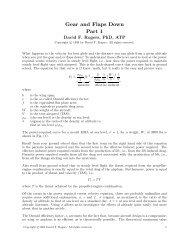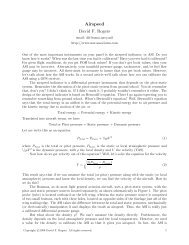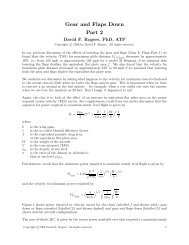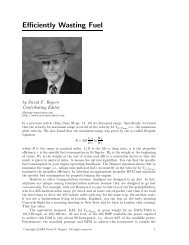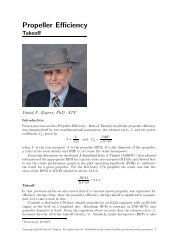Flight Determination of Partial Span Flap Parasite ... - NAR Associates
Flight Determination of Partial Span Flap Parasite ... - NAR Associates
Flight Determination of Partial Span Flap Parasite ... - NAR Associates
You also want an ePaper? Increase the reach of your titles
YUMPU automatically turns print PDFs into web optimized ePapers that Google loves.
approach and landing descent angles. Fully or partially deflected flaps may be used as<br />
speed brakes. Because small flap deflections result in proportionally greater increases in lift<br />
than in drag, partial flap extension may be used to decrease the take<strong>of</strong>f distance. <strong>Partial</strong><br />
flap extension may also be used to decrease the maneuvering turn radius. For multiengine<br />
aircraft, partial flap extension lift and drag characteristics are important for single engine<br />
climb performance. Typically, only partial span flaps are used because the trailing edge is<br />
also used for lateral control devices.<br />
A literature review revealed several early NACA technical reports, wartime reports<br />
and technical notes reporting wind tunnel experiments on NACA 230 mean line airfoils<br />
with slotted flaps, as well as a number <strong>of</strong> experiments on finite wings with full or partial<br />
span slotted flaps. The works <strong>of</strong> Wenzinger and Harris (Ref. 1) and House (Ref. 2) are<br />
representative <strong>of</strong> these efforts and particularly germaine to the present study.<br />
The experiments by Wenzinger and Harris compare and evaluate the characteristics <strong>of</strong><br />
an NACA 23012 airfoil with 0.2c split and plain flaps, along with 0.2667c external airfoil,<br />
Fowler and various single slotted flaps. They found that an optimum single slotted flap<br />
provided a superior maximum lift coefficient compared to split, plain and external airfoil<br />
flaps. However, the slot had to be carefully shaped and positioned to achieve optimal results.<br />
A Fowler flap provided a slightly higher maximum lift coefficient than the optimal single<br />
slotted flap but at the expense <strong>of</strong> additional complexity.<br />
House investigated the effects <strong>of</strong> center and tip located partial span flaps on finite wings<br />
<strong>of</strong> aspect ratio six. He concluded that center span flaps had higher values <strong>of</strong> maximum lift<br />
coefficient and that the values <strong>of</strong> C Lmax did not significantly change with an increase in flap<br />
span beyond 0.40b.<br />
The Aircraft<br />
The flight tests were conducted in an E33A Beech Bonanza. The aircraft had approximately<br />
600 hours on a recently installed Teledyne Continental Motors IO-520BB 285 BHP<br />
factory remanufactured six cylinder fuel injected engine. The aircraft has a fuel computer<br />
capable <strong>of</strong> measuring and displaying fuel flow and fuel remaining. The aircraft empty weight<br />
is 2142 lbs , including the weight <strong>of</strong> six gallons <strong>of</strong> unusable fuel and ten quarts <strong>of</strong> oil. The<br />
aircraft is equipped with a recently overhauled McCauley 3-blade propeller (3A32C76 hub<br />
with 82NB-2 blades) with a nominal diameter <strong>of</strong> 80 . The aircraft is fitted with a Century<br />
II autopilot and panel mounted IFR (Instrument <strong>Flight</strong> Rules) certified GPS avionics<br />
along with an S-TEC PSS60 altitude hold. This particular aircraft has the speed sweep<br />
windshield to reduce drag. Improved engine baffling for better engine cooling and reduced<br />
cooling drag has also been fitted. In addition, the Beechcraft “birdwing” antenna as well as<br />
the 10 ft belly ADF sense antenna have been removed to further reduce drag. The aircraft<br />
isshowninRogers(Ref.3).<br />
The Wing<br />
The aircraft wing span is 33.6 ft including wing tips (see Figure 1). The straight tapered<br />
wing has a taper ratio <strong>of</strong> 0.5. The quarter chord <strong>of</strong> the wing is unswept. The theoretical<br />
airfoil at the centerline <strong>of</strong> the aircraft is an NACA 23016.5 with a chord <strong>of</strong> 84 . The airfoil at<br />
the wing tip is an NACA 23012. The modified leading edge extension (LEX) at the aircraft<br />
centerline extends forward <strong>of</strong> the quarter chord by 37.6 , to yield a theoretical centerline<br />
Copyright c○2007-2009 David F. Rogers. All rights reserved. 2



